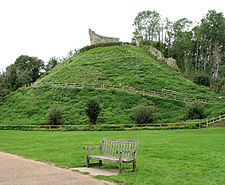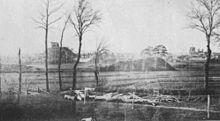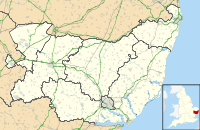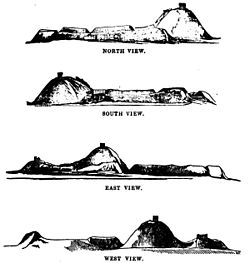- Clare Castle
-
Clare Castle Clare, Suffolk, England 
Motte of Clare CastleShown within SuffolkType Motte and bailey Coordinates grid reference TL771452 Construction
materialsFlint and rubble Current
conditionRuined; motte and outer bailey survive Current
ownerSuffolk County Council Open to
the publicYes Clare Castle is a medieval castle in the small town of Clare in Suffolk, England. Built shortly after the Norman conquest of England by Richard Fitz Gilbert, the motte and bailey castle was later improved in stone. In the 14th century the castle was the home of Elizabeth de Clare, one of the richest women in England, who maintained a substantial household there. The castle passed into the hands of the Crown, and by the 16th century was in ruins. Damaged by the construction of the Great Eastern Railway through the castle in 1867, the remains of the castle are now part of a local park and a scheduled monument and a grade 2* listed building.
Contents
History
11th - 13th centuries
Soon after the Norman conquest of England, Richard Fitz Gilbert was granted a barony by William the Conqueror, with two blocks of land, first in Kent and later across Suffolk and Essex.[1] Richard built two castles to defend his new lands, Tonbridge in Kent, followed by Clare Castle in Suffolk.[2] The exact date of the construction is unknown, but the first documentary records of the castle appear by 1090.[3] In the 11th century, Suffolk was one of the most prosperous parts of the country.[4]
 Tithe map of Clare Castle in 1846: A - Motte and keep; B - Inner bailey; C - Outer bailey; D - site of former water gardens; E - Chilton Stream
Tithe map of Clare Castle in 1846: A - Motte and keep; B - Inner bailey; C - Outer bailey; D - site of former water gardens; E - Chilton Stream
Clare Castle was built between the River Stour and the Chilton Stream and took the form of a motte and bailey design, with two baileys rather than the more common one.[5] The motte is 850 feet (259 m) wide at the base and 100 feet (30 m) tall, with its flat summit 63 feet (19 m) across.[5] The two baileys, stretching alongside from the motte along the north and east, were protected by deep ditches and steep palisades, with either a causeway or a drawbridge linking the inner to the outer bailey; the inner bailey was also sheltered by the curve of the Chilton.[6]
The castle was built on the site of a former Anglo-Saxon manor house, probably reflective of the wider Norman effort to demonstrate that their authority had replaced those of the previous lords.[7] Castles such as this were termed a caput, and as historian Robert Liddiard describes, as well as having a defensive value it also "represented and reflected the rank and dignity of the lord".[8] The castle was surrounded by three parks, including the Great Park at Hundon, established by 1090.[9] Like many other major castles, Clare was twinned with a local religious house when Richard de Clare founded Clare Priory in 1249, close to the castle, and grew to contain 29 friars.[10]
A new keep was built, probably in the 13th century. This took the form of a polygonal shell keep, with fourteen triangular buttresses supporting six foot (1.8 m) thick walls.[11] The inner bailey was strengthened with new stone walls, 20 to 30 feet (6 to 9 m) tall on top of the earlier earth banks, the walls and keep being built of flint and rubble.[12] The castle was manned during this period by a castle-guard system, in which lands were given out to local lords in return for their providing knights and soldiers to serve at the castle.[13]
14th century
By the early 14th century, before the outbreak of the Black Death, the town of Clare had a population of around 600.[14] The de Clares continued to own estates across England, but in Suffolk their possessions were concentrated in estates clustered around Clare Castle.[15] The castle was passed through the de Clare line until Gilbert de Clare died at the battle of Bannockburn in 1314, when the estate passed onto his sisters.[16] Elizabeth de Clare, whose husband John de Burgh had died the previous year, acquired the castle; the combined estates made Elizabeth one of the wealthiest women in England.[16] Elizabeth used the castle as her main residence between 1322 and 1360.[17]
The castle was well developed by this time, and was reached through three gates positioned across the wider estate, called Nethergate, Redgate and Dernegate.[18] The castle itself had four stone towers protecting the entrance to the inner bailey and the keep, called Auditorstower, Maidenstower, Constabletower and Oxfordtower.[18] Elizabeth built a chamber for her own use at the castle between 1346-7.[19] A substantial water-garden, forming part of the moat to the east, existed at the castle during this period; it may have included a fountain and probably had a geometric form, possibly similar to the garden at nearby St Benet's Abbey in Norfolk.[20] Vineyards and orchards surrounded the property.[18] The castle's three parks continued in active use, and, as part of the local rearing programme, the local deer were moved between them as the animals grew older.[21]
The castle and estates supported a luxurious, wealthy lifestyle by their owners - Elizabeth had an income of approximately £3,500 a year, most of which was spent on supporting her household, centred on Clare.[17][nb 1] Over £1,750 was spent on food and drink, including luxuries such as swans, salmon and German wines.[17][nb 2] Some goods could be bought locally, but others, such as furs, spices, cloth and wine, were imported for the castle through the international fairs held at Bury St Edmunds, Colchester, Ipswich, London, King's Lynn and Stourbridge.[23] The staff at Clare Castle included falconers, tailors, chaplains and goldsmiths, supported as necessary by 30 knights and squires.[24] The castle's bakers could produce up to 2,360 loaves of bread a day, and on average around 900 gallons (4, 091 litres) of ale were brewed every five days.[25][nb 3]
15th - 21st centuries
 Photograph of Clare Castle from the south in 1860, shortly before the inner bailey was destroyed by the construction of the Great Eastern Railway
Photograph of Clare Castle from the south in 1860, shortly before the inner bailey was destroyed by the construction of the Great Eastern Railway
After Elizabeth de Clare's death, Clare Castle passed by marriage into the Mortimers of Wigmore.[16] When Sir Edmund Mortimer acquired the castle in 1405, contemporaries reported it "in good repair and stocked".[16] The subsequent years saw the Mortimers heavily involved in the Wars of the Roses; after Edmund's death in 1425, the castle passed to Richard of York and in turn, via his son Edward IV, to the Crown.[16]
The castle deteriorated during this period, and by the time that the antiquarian John Leland visited in the 16th century, it was in ruins, except for one of the towers which was being used as a local prison.[27] The masonry of the castle had probably been stripped for use as local building materials, as this part of England was traditionally very short of suitable stone.[16] Edward VI gave the castle to Sir John Checke, until it reverted to Mary I.[16] After Mary, the castle was acquired by Sir Gervase Elwes, whose family retained it until the 19th century.[16] At some point after 1720, the surviving east and south sides of the inner bailey walls were destroyed.[3]
In 1867 the Cambridge and Colchester branch line of the Great Eastern Railway was built through the castle, cutting across and largely destroying the inner bailey in order to make room for a new station.[28][nb 4] The railway line was later closed in 1967 as part of the Beeching Axe.[30]
The castle now consists of a motte, on which a part of the keep still stands and the outer bailey earthworks; fragments of the inner bailey stone wall can also still be seen.[3] The disused station, goods yard and the castle grounds have been developed into a landscaped country park, interlaced with water in the old moats, called Clare Castle Country Park, which is crossed by the Stour Valley Path.[31] The castle is a scheduled monument and a grade 2* listed building.[32]
See also
- Castles in Great Britain and Ireland
- List of castles in England
Notes
- ^ It is impossible to accurately compare 14th century and modern prices or incomes. For comparison, £3,500 represents several times the typical average annual income for an early 15th century baron.[22]
- ^ It is impossible to accurately compare 14th century and modern prices or incomes. For comparison, £1,750 represents over one and half times the typical average annual income for an early 15th century baron.[22]
- ^ One of the reasons for the high quantities of bread produced was because it was common to pay wages in the form of bread during this period.[26]
- ^ A 15th century gold pectoral cross was found during the building work, which was given to Queen Victoria.[29]
References
- ^ Pounds, p.61; Mortimer, pp.119-141, cited Green, p.6.
- ^ Pounds, p.61.
- ^ a b c Clare Castle, National Monuments Record, English Heritage, accessed 2 July 2011.
- ^ Dyer, p.63.
- ^ a b Wall, p.595.
- ^ Wall, p.595 Tymms, p.65; Clare Castle, National Monuments Record, English Heritage, accessed 2 July 2011.
- ^ Liddiard (2005a), p.36; Liddiard (2005b), p.30.
- ^ Liddiard (2005b), p.41.
- ^ Hoppit, p.152; Harper-Bill, p.39.
- ^ Emery, p.78; Liddiard (2005a), p.38.
- ^ Tymms, p.65.
- ^ Tymms, pp.65-6.
- ^ King, p.16.
- ^ Bailey, p.129.
- ^ Bailey, p.17.
- ^ a b c d e f g h Mackenzie, p.276.
- ^ a b c Bailey, p.18.
- ^ a b c Underhill, p.67.
- ^ Emery, p.78.
- ^ Liddiard (2005a), p.41; Liddiard (2005b), p.114.
- ^ Liddiard (2005b), p.103.
- ^ a b Pounds, p.148.
- ^ Holmes, p.111.
- ^ Bailey, pp.18-9.
- ^ Underhill, pp.68-70.
- ^ Underhill, p.68.
- ^ Pounds, p.257.
- ^ Way, p.60.
- ^ Way, p.61.
- ^ Branch Line, The Reshaping of the Stour Valley Line, V. W. Hinkley, accessed 26 July 2011.
- ^ Hull, p.196; Welcome to Clare Castle Country Park, Suffolk County Council, accessed 2 July 2011.
- ^ Clare Castle, Gatehouse website, accessed 1 July 2011.
Bibliography
- Bailey, Mark. (2010) Medieval Suffolk: An Economic and Social History, 1200-1500. Woodbridge, UK: Boydell Press. ISBN 9781843835295.
- Dyer, Christopher. (2009) Making a Living in the Middle Ages: The People of Britain, 850 – 1520. London: Yale University Press. ISBN 9780300101911.
- Emery, Anthony. (2006) Greater Medieval Houses of England and Wales, 1300–1500: Southern England. Cambridge: Cambridge University Press. ISBN 9780521581325.
- Green, Judith A. (1997) The Aristocracy of Norman England. Cambridge: Cambridge University Press. ISBN 9780521524650.
- Harper-Bill, Christopher. (ed) (2005) Medieval East Anglia. Woodbridge, UK: Boydell Press. ISBN 9781843831518.
- Holmes, G. (1957) Estates of the Higher Nobility in Fourteenth Century England. Cambridge: Cambridge University Press. ISBN 9780521116541.
- Hull, Lise E. (2009) Understanding the Castle Ruins of England and Wales: How to Interpret the History and Meaning of Masonry and Earthworks. Jefferson, US: MacFarland. ISBN 9780786434572.
- King, D. J. Cathcart. (1991) The Castle in England and Wales: An Interpretative History. London: Routledge. ISBN 0415003504.
- Liddiard, Robert. (2005a) "The Castle Landscape of Anglo-Norman East Anglia: A regional perspective," in Harper-Bill (ed) (2005).
- Liddiard, Robert. (2005b) Castles in Context: Power, Symbolism and Landscape, 1066 to 1500. Macclesfield, UK: Windgather Press. ISBN 0954557522.
- MacKenzie, James Dixon. (1896/2009) The Castles of England: Their Story and Structure. General Books LLC. ISBN 978-1-150-51044-1.
- Mortimer, R. (1981) "The Beginnings of the Honour of Clare," Anglo-Norman Studies 3, pp.119-141.
- Page, William. (ed) (1911) The Victoria History of Suffolk, Vol. 1. London: University of London.
- Pounds, Norman John Greville. (1994) The Medieval Castle in England and Wales: a social and political history. Cambridge: Cambridge University Press. ISBN 9780521458283.
- Tymms, S. (1849) "Clare Castle," Proceedings of the Suffolk Institute of Archaeology and History 1:3, pp.61-66.
- Underhill, Frances Ann. (1999) For her good estate: the life of Elizabeth de Burgh. New York: St Martin's Press. ISBN 9780312213558.
- Wall, J. C. (1911) "Ancient Earthworks," in Page (ed) (1911).
- Way, Albert. (1868) "Gold Pectoral Cross found at Clare Castle", The Archaeological Journal, 25, pp.60-71.
Categories:- Ruins in Suffolk
- Castles in Suffolk
- Visitor attractions in Suffolk
Wikimedia Foundation. 2010.


